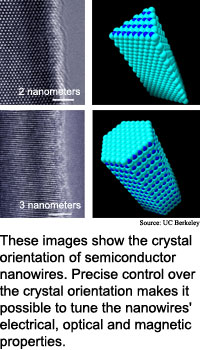
Crystal structure tunes nanowires
Several groups of researchers are working
to control the growth of wires that can be as narrow as a few atoms in
diameter and that can be used as nanoscale electronic components. Researchers
have been able to grow nanowires that have specific material compositions,
and at specific positions and orientations.
Researchers from the University of California at Berkeley and
Lawrence Berkeley National Laboratory have added a new dimension to making
nanowires. They have found a way to control the crystal structure of nanowires
made from the semiconductor materials gallium nitride and zinc oxide.
The process promises to enable electronic components like light-emitting
diodes and laser diodes that have tunable properties, according to the
researchers.
Crystals have a lattice structure, and depositing a thin layer
of a material on a crystal surface causes the material to adopt the crystal
structure of the surface. The researchers were able to coax nanowires
to grow with a particular crystal orientation by matching the lattice
of the surface crystal with the desired structure of the nanowire.
The researchers used the method to grow nanowires 15 to 40 nanometers
in diameter. One crystal structure contained nanowires with a triangular
cross-section, and a second type had a hexagonal cross-section.
This type of control is key to making useful components from nanowires.
The researchers found that that gallium nitride nanowires grown with different
crystal structures emit light at different wavelengths.
Nanowires could be used in practical miniaturized ultraviolet
light sources in two to five years, according to the researchers. The
work appeared in the July 25, 2004 issue of Nature.
Atomic clock to sync handhelds
Quantum math models speech
Page layout drives Web search
Fluid chip does binary logic
Briefs:
Chip spots DNA electrochemically
Crystal structure tunes nanowires
Gas flow makes electricity
Sound makes electricity for space
Design rules build on self-assembly
Nanotube diode reverses itself

Research Watch blog
View from the High Ground Q&A
How It Works
RSS Feeds:
News
Ad links:
Buy an ad link
Ad links: Clear History
Buy an ad link
|
TRN
Newswire and Headline Feeds for Web sites
|
© Copyright Technology Research News, LLC 2000-2010. All rights reserved.